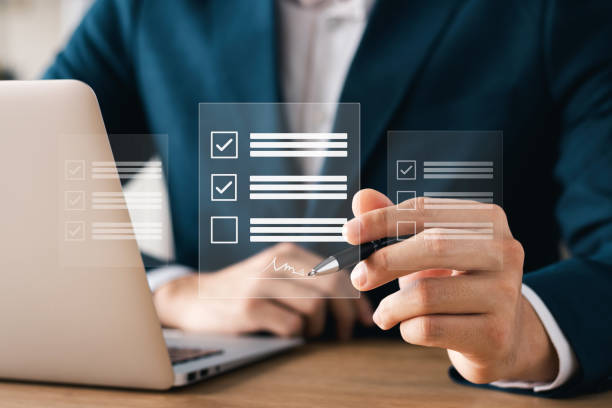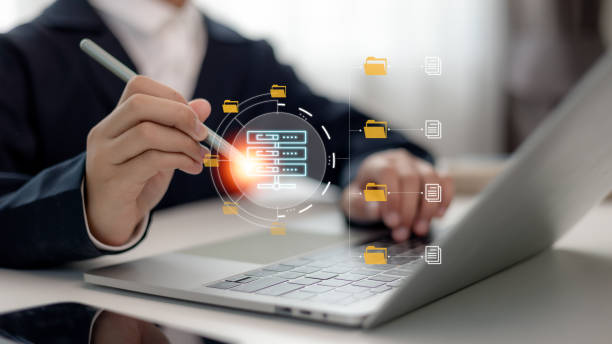What is Internal SEO and Why is it Important?

Internal SEO or On-Page SEO refers to the set of actions you take within your website to improve your site’s ranking in search results on #Google and other search engines.
These actions include optimizing content, site structure, HTML tags, and other internal elements of the website.
Why is Internal SEO Important?
Search engines like Google rank websites based on various factors.
One of the most important factors is internal SEO.
A website that is well optimized for internal SEO is more likely to achieve a higher ranking in search results.
This means increased traffic, attracting more audiences, and ultimately increasing sales and revenue.
By improving internal SEO, you are actually helping search engines better understand the content of your site and display it to more relevant users.
This is especially important in today’s competitive market, as websites with stronger internal SEO have a better chance of being seen and attracting audiences.
More information about SEO.
Ultimately, investing in internal SEO is investing in the long-term success of your website.
By continuously optimizing your website for internal SEO, you can increase your organic traffic, improve your brand reputation, and ultimately achieve your business goals.
To achieve the desired results, you should also use appropriate SEO tools.
Did you know that 94% of users’ first impressions of a business are related to its website design? With professional corporate website design by **Rasaweb**, turn this first impression into an opportunity for growth.
✅ Attract more customers and increase sales
✅ Create credibility and trust in the eyes of the audience⚡ Get a free website design consultation!
Keyword Research and Choosing the Best Ones
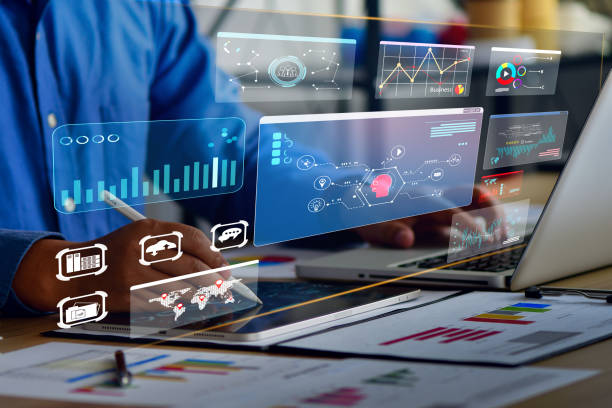
Keyword research is the cornerstone of any successful internal SEO strategy.
Choosing the right keywords helps you produce content based on the needs and interests of your target audience and rank in search results for terms that users are actually looking for.
Steps of Keyword Research:
- Identify Main Topics First, identify the main topics of your business.
- Keyword Brainstorming Create a list of words and phrases related to your main topics.
- Use Keyword Research Tools Use tools like Google Keyword Planner, Ahrefs, SEMrush, etc.
to find related keywords, check search volume, and competition levels.
Compare keyword research tools. - Analyze Competitors Identify and analyze your competitors’ keywords.
- Select Target Keywords Based on search volume, competition level, and relevance to your business, select your target keywords.
When choosing keywords, pay attention to the following:
- User Intent What is the user’s intent in searching for that keyword?
- Relevance How relevant is the keyword to your content?
- Competition How much competition is there for the keyword?
Keep in mind that choosing the right keywords is the first step on the path to success in internal SEO.
By spending enough time and attention at this stage, you can lay the foundation for a strong SEO strategy and significantly increase your organic traffic.
Consider the importance of long-tail keywords as well.
Optimizing the Page Title (Title Tag)
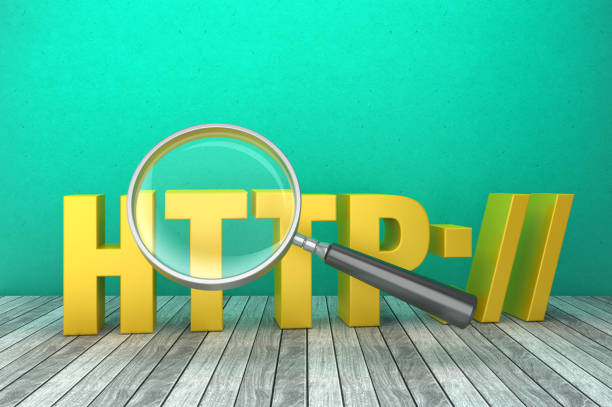
The title tag is one of the most important internal SEO elements that helps search engines and users understand the main topic of your page.
An optimized title tag not only helps improve your ranking in search results, but also increases the click-through rate (CTR), as it encourages users to click on your link.
Important Tips for Title Tag Optimization
- Use the Main Keyword Place your main keyword at the beginning of the title tag.
This tells search engines that your page is relevant to this keyword. - Appropriate Length The length of the title tag should be between 50 and 60 characters to be fully displayed in search results.
- Attractive and Persuasive The title tag should be attractive and persuasive to encourage users to click on your link.
- Uniqueness Each page should have a unique title tag.
Avoid using duplicate title tags.
Examples of Optimized Title Tags
- Buy Laptop: Best Prices and Latest Models – Online Store
- SEO Training: Comprehensive and Practical Guide for Beginners
- Chocolate Cake Recipe: Easy and Delicious Recipe
By following these tips, you can optimize your title tags and improve your ranking in search results.
Continue with internal SEO in the right way.
| Feature | Description | Example |
|---|---|---|
| Keyword | Use the main keyword | Buy Laptop |
| Length | Between 50 and 60 characters | Buy Laptop: Best Prices |
| Attractiveness | Attract users to click | SEO Training: Comprehensive Guide |
| Uniqueness | No repetition on different pages | Each page has a different title |
Optimizing the Meta Description

The Meta Description is a short summary of your page’s content that appears in search results below the page title.
Although the meta description does not directly affect your ranking in search results, it can increase the click-through rate (CTR) because it helps users understand what your page is about and whether it’s worth clicking on.
Important Tips for Meta Description Optimization
- Use Relevant Keywords Use keywords related to your page’s content in the meta description.
- Appropriate Length The length of the meta description should be between 150 and 160 characters to be fully displayed in search results.
- Attractive and Persuasive The meta description should be attractive and persuasive to encourage users to click on your link.
- Uniqueness Each page should have a unique meta description.
Avoid using duplicate meta descriptions.
Examples of Optimized Meta Descriptions
- Buy laptops with the best prices and the latest models from the online store.
Free shipping throughout the country. - SEO training step by step and with practical examples.
This guide is designed for beginners. - Homemade chocolate cake recipe with an easy and delicious recipe.
Prepare this cake in less than an hour.
By optimizing the meta description, you can increase your click-through rate and attract more organic traffic to your website.
Don’t forget that internal SEO requires attention to detail.
Does your current site reflect your brand’s credibility as it should? Or does it drive away potential customers?
Rasaweb, with years of experience in designing professional corporate websites, is your comprehensive solution.
✅ A modern, beautiful site tailored to your brand identity
✅ Significant increase in lead generation and new customers
⚡ Contact Rasaweb now for a free corporate website design consultation!
Optimizing URLs

The address of your website pages (URL) plays an important role in SEO.
Optimized URLs not only help search engines better understand the topic of your page, but also improve the user experience.
Short, readable, and content-related URLs help users easily find the page they are looking for and remember it.
Important Tips for URL Optimization
- Short and Readable URLs should be short and readable.
Avoid using long and complex words. - Use Keywords Use keywords related to your page’s content in the URL.
- Use a Hyphen (-) Use a hyphen (-) to separate words in the URL.
- Do Not Use Uppercase Letters URLs should be written in lowercase.
Examples of Optimized URLs
www.example.com/blog/seo-internalwww.example.com/products/laptopwww.example.com/recipes/chocolate-cake
Avoid creating long, complex, and incomprehensible URLs.
By optimizing URLs, you can improve your website’s SEO and enhance the user experience.
Do internal SEO carefully.
Optimizing Images

Images play an important role in the attractiveness and better understanding of your website’s content.
But unoptimized images can slow down your page loading speed and negatively affect your SEO.
By optimizing images, you can increase the loading speed of your pages, improve the user experience, and improve your ranking in search results.
Important Tips for Image Optimization
- Choose the Right Format Use the appropriate format for your images.
JPEG is suitable for photos and complex images, while PNG is better for images with transparent backgrounds and icons. - Reduce Image Size Reduce the size of your images without losing quality.
You can use online tools or image editing software for this purpose.
Introducing image optimization tools. - Use Alt Tag Write a suitable and descriptive Alt tag for each image.
The Alt tag helps search engines understand the topic of the image and achieve a better ranking in image search results. - Appropriate File Name Choose the file name of your images with relevant keywords.
By optimizing images, you can improve your website’s SEO and enhance the user experience.
Internal SEO helps you with this.
Optimizing Page Content

High-quality and optimized content is the beating heart of any successful website.
Search engines rank websites that provide valuable, relevant, and up-to-date content higher.
By optimizing page content, you can increase your organic traffic, attract your audience, and achieve your business goals.
Important Tips for Page Content Optimization
- Keyword Research Before writing content, do keyword research and identify keywords related to your topic.
- Use Keywords Use your keywords naturally and in appropriate places in your content.
Avoid overusing keywords (Keyword Stuffing). - Appropriate Structure Organize your content in a structured way using Headings, Subheadings, and Paragraphs.
- Readability Write your content in a way that is easy to read.
Use short sentences, simple words, and a friendly tone. - Value Your content should be valuable to your audience and answer their questions or solve their problems.
- Update Update your content regularly to add new information and prevent information from becoming obsolete.
By producing high-quality and optimized content, you can improve your website’s SEO and attract more audiences.
Internal SEO plays a vital role here.
| Element | Description | Importance in SEO |
|---|---|---|
| Keywords | Smart use of keywords | Identifying the topic and purpose of the content |
| Structure | Using headings and subheadings | Improving readability and organization |
| Readability | Using simple sentences and words | Improving user experience |
| Value | Being useful and practical for the audience | Increasing time spent on the site |
Internal Linking
![]()
Internal linking refers to the process of creating links between different pages of your website.
Internal linking helps search engines better understand the structure of your website, identify more important pages, and distribute value (PageRank) between different pages.
Also, internal linking can improve the user experience, as it helps users easily navigate your website and find the information they need.
Important Tips for Internal Linking
- Relevance Links should be relevant to the content of the source and destination page.
- Use Appropriate Link Text (Anchor Text) Use appropriate and descriptive link text for your internal links.
The link text should briefly describe the topic of the destination page. - Appropriate Number of Links Use an appropriate number of links on each page.
Over-linking can damage your SEO. - Link to Important Pages Link to important pages of your website to increase their value.
By performing internal linking correctly, you can improve your website’s SEO and enhance the user experience.
Internal SEO is strengthened by linking.
Research more about linking strategies for more information.
Are you tired of your company’s website not being seen as it should be and losing potential customers? Solve this problem forever with professional and effective website design by Rasaweb!
✅ Increase brand credibility and gain customer trust
✅ Attract targeted sales leads
⚡ Contact us now for a free consultation!
Page Loading Speed

Page loading speed is one of the most important factors in SEO and user experience.
Today’s internet users have little patience and expect website pages to load in seconds.
If your page loads slowly, users will leave it, and this can damage your SEO.
How to Improve Page Loading Speed?
- Optimize Images Optimize your images to reduce their size.
- Use Cache Use cache to store static files of your website to increase page loading speed.
- Optimize Code Optimize your website’s code and avoid unnecessary and unnecessary code.
- Use CDN Use a CDN (Content Delivery Network) to distribute your website’s content on different servers around the world to improve page loading speed for users in different regions.
- Choose the Right Host Use a reputable and high-quality hosting company that provides high-speed and stable servers.
By improving page loading speed, you can improve your website’s SEO, enhance the user experience, and increase your conversion rate.
Internal SEO and page loading speed are directly related.
Mobile-Friendly Website
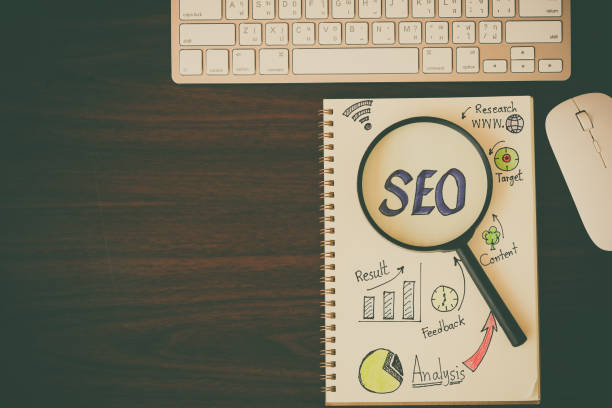
With the increasing use of mobile phones to access the Internet, being Mobile-Friendly (compatibility with mobile) of the website has become of particular importance.
Google ranks websites that are optimized for mobile higher.
If your website is not Mobile-Friendly, you may lose your organic traffic.
How to Make Your Website Mobile-Friendly?
- Use Responsive Design Use responsive design to automatically adjust your website to the screen size of different devices (mobile, tablet, desktop).
- Optimize Page Loading Speed Optimize page loading speed for mobile users.
- Use Readable Fonts Use readable fonts for mobile users.
- Avoid Flash Content Do not use Flash content, as it is not supported on many mobile devices.
- Test Website Test your website on different mobile devices to ensure its compatibility.
By making your website Mobile-Friendly, you can improve your website’s SEO, enhance the user experience, and attract more audiences.
Internal SEO is not complete without paying attention to being Mobile-Friendly.
FAQ
| Row | Question | Answer |
|---|---|---|
| 1 | What is Internal SEO (On-Page SEO)? | Internal SEO refers to the set of actions taken within a website (on its pages) to improve the site’s ranking in search engine results. This includes optimizing content, site structure, and HTML codes. |
| 2 | Why is Internal SEO important? | Internal SEO helps search engines better understand page content and determine whether that page is relevant and valuable to user searches. This better understanding leads to a higher ranking. |
| 3 | What is the first and most important step in internal SEO? | Keyword Research is the most important initial step. By finding the right keywords, targeted content relevant to users’ needs can be produced. |
| 4 | What is the role of the Title Tag in internal SEO? | The title tag is one of the most important ranking factors and should include the main keyword. This tag is displayed in search results as the page title and affects the click-through rate (CTR). |
| 5 | What is the importance of Meta Description? | The meta description does not directly affect ranking, but by providing an attractive summary of page content in search results, it can encourage users to click and thus increase the click-through rate (CTR). |
| 6 | Why is using headings (H1, H2, etc.) important in content? | Headings help structure content and improve readability for users and search engine crawlers. Using keywords in headings also helps the search engine better understand the topic. |
| 7 | What does Image Optimization in internal SEO include? | It includes compressing images to reduce size, using descriptive and relevant file names, and filling the Alt tag (alternative text) with relevant keywords to help search engines understand the image content. |
| 8 | What is meant by Internal Linking in internal SEO? | Internal linking refers to creating links between different pages of a website. This helps distribute page authority (Link Equity), improve the user experience, and help search engine crawlers discover new pages. |
| 9 | Why is Page Speed important for internal SEO? | Page loading speed is a direct ranking factor and greatly affects the user experience. Slow pages can increase the bounce rate and reduce user engagement. |
| 10 | What role does quality content play in internal SEO? | Quality content that is comprehensive, unique, and valuable to the user is the core of internal SEO. This content not only attracts and retains users but also sends positive signals to search engines and helps in better ranking. |
and other services of Rasa Web Advertising Agency in the field of advertising
Intelligent Data Analysis: A combination of creativity and technology to increase sales by using real data.
Intelligent Custom Software: A fast and efficient solution for user interaction with a focus on marketing automation.
Intelligent Conversion Rate Optimization: A creative platform to improve website traffic by customizing the user experience.
Intelligent Sales Automation: A fast and efficient solution to increase click-through rates with a focus on Google ad management.
Intelligent Marketplace: A combination of creativity and technology for user interaction by optimizing key pages.
And more than a hundred other services in the field of internet advertising, advertising consulting, and organizational solutions
Internet Advertising | Advertising Strategy | Advertorial Report
Resources
What is Internal SEO? A Guide to Internal Website SEO in 2024
,What is Internal SEO (on-page seo)? Ways to Increase Internal Website SEO
,What is Internal SEO (On-Page SEO)? A Complete Guide to Internal SEO
,What is Internal SEO? — On-Page SEO Training
? Are you ready to take your business to the top in the digital world? Rasaweb Afarin, a leading digital marketing agency, specializing in search engine optimization (SEO), content marketing, and responsive website design, offers innovative and comprehensive solutions for your growth and visibility. We help you achieve your business goals and outperform your competitors with a strong and impactful online presence.
📍 Tehran, Mirdamad Street, next to the Central Bank, Southern Kazerun Alley, Ramin Alley, No. 6

